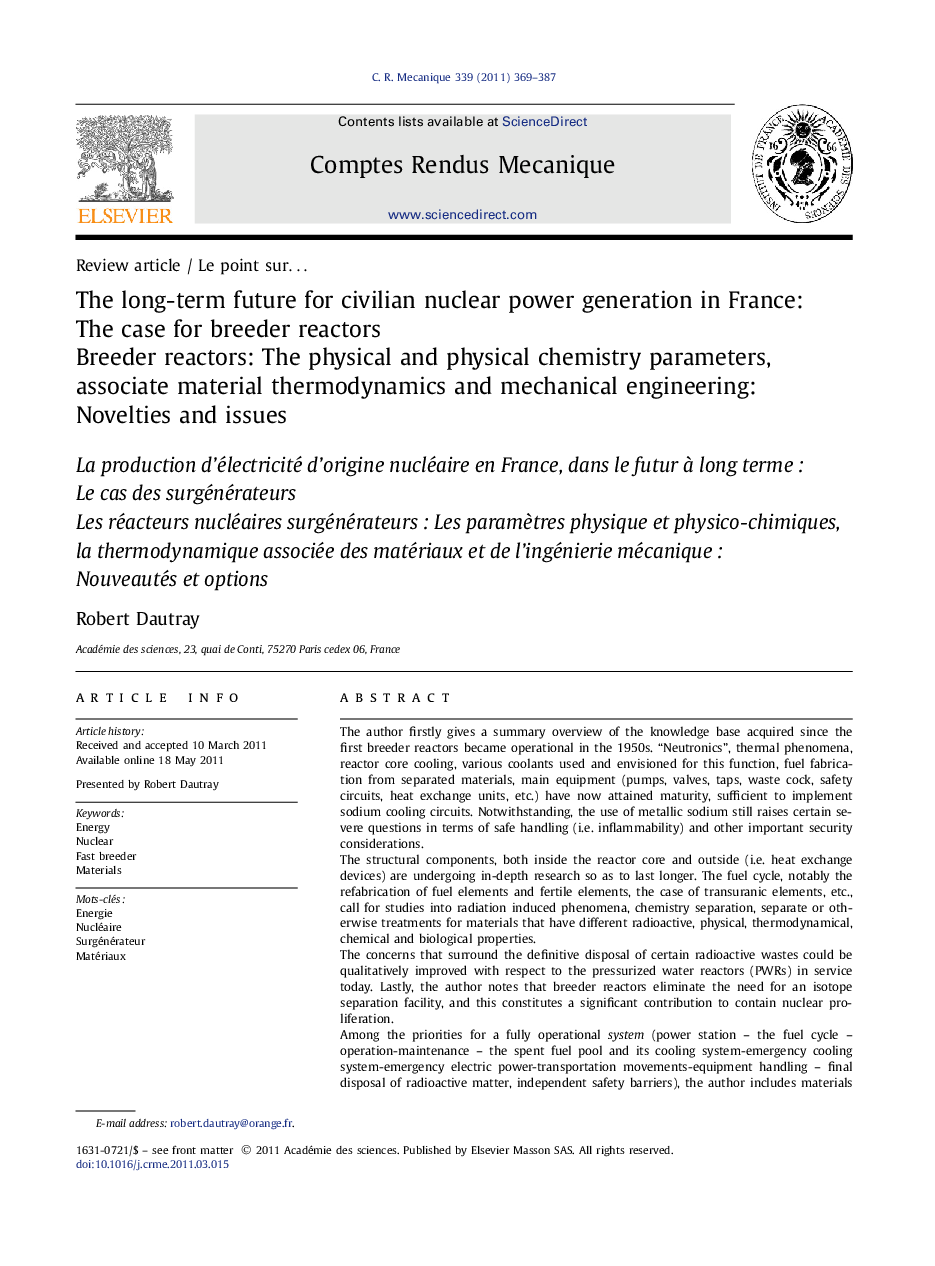| Article ID | Journal | Published Year | Pages | File Type |
|---|---|---|---|---|
| 823981 | Comptes Rendus Mécanique | 2011 | 19 Pages |
The author firstly gives a summary overview of the knowledge base acquired since the first breeder reactors became operational in the 1950s. “Neutronics”, thermal phenomena, reactor core cooling, various coolants used and envisioned for this function, fuel fabrication from separated materials, main equipment (pumps, valves, taps, waste cock, safety circuits, heat exchange units, etc.) have now attained maturity, sufficient to implement sodium cooling circuits. Notwithstanding, the use of metallic sodium still raises certain severe questions in terms of safe handling (i.e. inflammability) and other important security considerations.The structural components, both inside the reactor core and outside (i.e. heat exchange devices) are undergoing in-depth research so as to last longer. The fuel cycle, notably the refabrication of fuel elements and fertile elements, the case of transuranic elements, etc., call for studies into radiation induced phenomena, chemistry separation, separate or otherwise treatments for materials that have different radioactive, physical, thermodynamical, chemical and biological properties.The concerns that surround the definitive disposal of certain radioactive wastes could be qualitatively improved with respect to the pressurized water reactors (PWRs) in service today. Lastly, the author notes that breeder reactors eliminate the need for an isotope separation facility, and this constitutes a significant contribution to contain nuclear proliferation.Among the priorities for a fully operational system (power station – the fuel cycle – operation-maintenance – the spent fuel pool and its cooling system-emergency cooling system-emergency electric power-transportation movements-equipment handling – final disposal of radioactive matter, independent safety barriers), the author includes materials (fabrication of targets, an irradiation and inspection instrument), the chemistry of all sorting processes, equipment “refabrication” or rehabilitation, etc., radioprotection measures and treatment for the “transuranic” elements. For a long period of time, France was in the forefront of nuclear breeder power generation science, technological research and also in the knowledge base related to breeder reactors. It is in the countryʼs interest to pursue these efforts and this could per se constitute one of the national priorities.1
RésuméLes connaissances acquises depuis les premières réalisations de surgénérateurs dans le début des années cinquante sont récapitulées. La neutronique, les phénomènes thermiques, le refroidissement du cœur du réacteur, les divers fluides envisagés pour cette fonction, la fabrication des combustibles à partir de corps purs, les gros équipements (pompes, vannes, purgeur, circuits de secours, échangeurs de chaleur, etc.) ont atteint une solide maturité pour le refroidissement par sodium. Celui-ci, toutefois, pose encore des problèmes pour les manutentions et leur sureté.Les matériaux de structures, tant à lʼintérieur du cœur quʼà lʼextérieur (échangeurs de chaleur) font lʼobjet de recherches approfondies. Le cycle des combustibles, et notamment la « re-fabrication » dʼéléments combustibles et dʼéléments fertiles, le sort des transuraniens, etc. demandent des études dʼirradiations, de séparation chimique, de traitements séparés ou non des corps ayant des propriétés radioactives, chimiques et biologiques différentes.Les préoccupations liées au sort ultime de certains déchets radioactifs, pourraient être qualitativement améliorés par rapport aux filières de réacteurs à eau existant aujourdʼhui. Enfin, les surgénérateurs suppriment la nécessité dʼavoir recours à une usine de séparation isotopique, ce qui est une contribution substantielle pour contenir une éventuelle prolifération.Parmi les priorités du système complet : centrale-cycle de combustible-maintenance-déplacements-manutentions-sort ultime des corps radioactifs, comptons les matériaux (donc un instrument dʼirradiation et dʼexamen), la chimie de tous les procédés de triage, de re-fabrication, de corrosion, de fabrication des équipements, etc., la sûreté-radioprotection et les transuraniens. La France a longtemps été au premier rang des recherches et des acquis dans les divers domaines concernés par les surgénérateurs. Il sʼagit de continuer cet effort qui pourrait être une des priorités nationales.1
